Can Renewable Energy From Weather-Related Sources Replace Fossil Fuels?
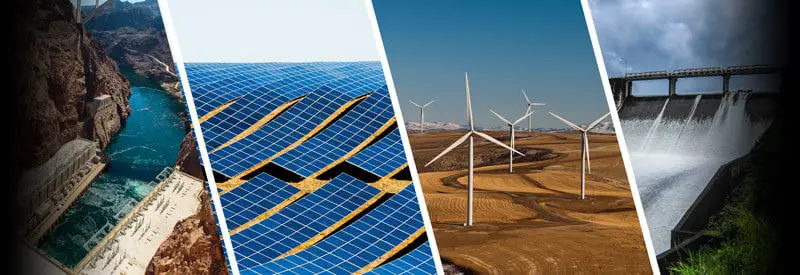
Renewable energy from weather-related resources is increasingly used to supplement conventional power sources. But whether it is capable of replacing fossil fuels as a whole is a widely debated topic.
Currently, renewable energy resources related to weather can support but not yet replace fossil fuels. Accounting for less than 20% of the total energy produced globally, it is not just a case of insufficient capacity but the inconsistent availability of renewable sources like solar and wind power.
Renewable weather sources like sunlight, wind, and hydroelectric energy have also been integrated into the national power grid of a number of countries. Many households have become self-sustained and independent from public energy utilities.
The Alternative & Renewable Energy Sector already resulted in the birth and growth of a number of related industries. For example, solar and wind farms are rapidly appearing worldwide in areas with the most favorable exposure to weather resources.
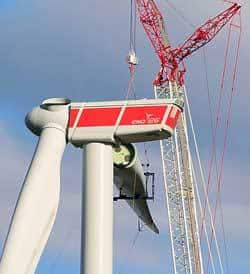
This also has the added benefit of the creation of a new job market as the sector continues to grow. People who specialize or have skills needed in this growing field will be in high demand. New doors will also open for jobs that have yet to be created for the young industry.
However, the big question most governments and industries are asking is whether weather-related renewable sources of energy can completely replace fossil fuels as our primary source of power.
We will delve into this question first. Then, we will look more closely at the different renewable sources of energy produced by the weather, their potential, as well as their biggest advantages and drawbacks.
This is not a quick and easy question to answer. So, the short and "simple" and answer first:
Can Renewable Energy From The Weather Replace Fossil Fuels?
Currently, renewable energy resources related to weather can support but not yet replace fossil fuels. Accounting for less than 20% of the total energy produced globally, it is not just a case of insufficient capacity but the inconsistent availability of renewable sources like solar and wind power.
Yes, this is a very unsatisfactory and simplistic answer. But it is a very complicated question to a very complex issue, as you will soon find out. Several factors simply make it impossible to answer this question one way or the other definitively.
The best way to explain why renewable energy sources can not completely replace fossil fuels, currently or in the near future, is by looking at the limitations and issues faced by the sector on a variety of fronts.
Current Limitations And Issues Faced By Renewable Power Sources
There are several financial and other issues prohibiting the implementation of renewable (alternative) power sources on a large scale and over a short period. These issues are also the reason why we currently can't stop the use of fossil fuels for energy generation.
1) The Current Disproportional Spread Of Energy Sources
As of 2018, only around 17.1% of the world's energy requirements are provided by sources of renewable energy. And these are all the sources of renewable power combined, including solar, wind, hydro, and wave energy.
On the other hand, fossil fuels and nuclear energy are currently meeting around 90% of the world's energy demands. Needless to say, the vast majority of the global population is still dependent on fossil fuels and other non-renewable power sources.
Especially with global politics and economics involved, it is not possible to replace traditional power sources with renewable ones over a short period. Even if everyone agreed and worked together, logistics and insufficient power capacity make this an impossible feat.
2) Intermittent and Unreliable Power Supply
This argument is based on the fact that both solar and wind power are not consistently available, unpredictable, and as a result, unreliable.
The sun does not shine for half the day and is also influenced by factors such as cloud coverage, making it difficult to estimate the amount of energy solar energy can produce.
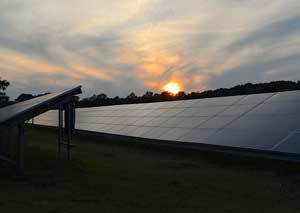
Similarly, wind power completely relies on the presence of wind. Even placing wind farms in areas experiencing prolonged periods of strong winds is no guarantee that wind will always be present at predetermined minimum speeds to produce the amount of energy required.
The storage of power through large battery cells and other forms of power storage may provide a possible solution. However, much more research on storage power has to be done before storing this amount of energy becomes a viable option.
3) Substantial Space Requirements
Depending on where the renewable power sources are needed, this may be a big problem or no problem whatsoever. If you live in a large country with plenty of big open spaces, like deserts or mountainous regions experiencing favorable conditions, this not an issue at all.
It is in countries which are densely populated with almost no available open spaces where this becomes a real problem. You only need to look at pictures of solar and wind farms to get an idea of the sheer amount of space they utilize.
To put everything into context, solar and wind farms require approximately 40-50 times the amount of space of one coal-powered station to generate the same amount of power.
In the case of a gas-powered station, the equivalent is a staggering 90-100 times more space required by solar and wind farms.
This problem is not insurmountable, however. As solar technology keeps evolving, panels able to produce more power while using up less space will significantly reduce the problem.
Rooftop placement of solar panels is already used in domestic households and industries. Implementing it on a large scale will reduce the problem for countries with limited space.
The same applies to wind farms where the placement of wind turbines in farmlands or offshore, where it doesn't compete for space with other developments.
4) Potential Vulnerability Of Renewable Infrastructure
Because it is deployed over such large areas and needs to be completely exposed to the weather elements to function optimally, renewable energy infrastructure is more prone to damage than traditional power stations.
Solar panels and wind turbines are designed to withstand harsh weather over long periods. This makes them durable enough to continue to operate nonstop over extended periods of time as intended, but they are infallible.
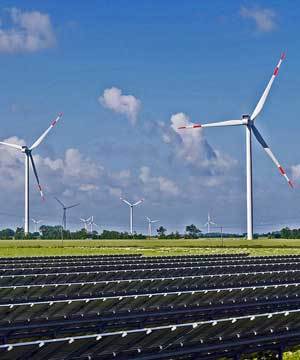
As extreme weather events continue to grow in size and frequency every year, these installations will be increasingly threatened. Damage or the destruction of a solar or wind farm can cause severe disruptions in the delivery of power to intended destinations.
Coal and gas-powered stations are more robustly built, and because they take a fraction of the space their renewable counterparts use, they are much less likely to be affected by severe weather. Skeptics of renewable power sources will be quick to point this fact out to you.
These are just a few of the uphill battles, that protagonist and governments who want to move towards alternative cleaner energy sources, have to fight every day.
Players involved in the Renewable Energy Sector are well aware of these issues. Since technological advances in this sector kicked into high gear over the last decade, equipment and infrastructure will continue to improve to address any issue at a rapid rate.
At this point, you may be wondering why there is such a hard push towards renewable energy, especially with all the issues and limitations it is facing. Well, I don't need to mention the effects of climate change. You are probably already well aware of its causes and effects.
If you live in a densely populated urban area or metropolis, it is already affecting and may be causing you some severe discomfort. If you want to find out how, as well as what the Urban Heat Island is, you can read the whole article here.
The Different Sources Of Renewable Energy
There is clearly a number of difficulties and obstacles that the Renewable Energy Industry needs to address and overcome.
It has, however, already developed and evolved into a much more efficient and reliable alternative energy source. In many countries, renewable energy has already been integrated into existing power grids, supplementing conventional power and boosting capacity.
This brings us to the different renewable energy sources provided by the weather, either directly or indirectly. We will look at each individual weather source, its potential, and some potential drawbacks and shortcomings...
1) Solar Power As A Renewable Energy Source
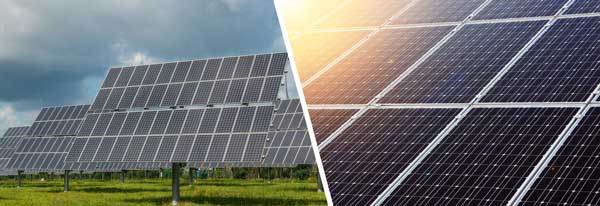
Even though the widespread use of solar energy has already made it a familiar sight, it is sometimes not completely understood and needs to be more precisely defined.
Solar energy is the heat and light which are emitted by the sun, captured, and then converted into different forms of energy. Heat and electricity are two of the primary forms of energy produced.
As a result of being a renewable source of energy, sunlight can continue to provide energy without using up resources. It is also a clean source of power, meaning no emissions or byproducts are generated that can influence or cause any harm to the environment.
How Solar Energy Is Produced
The most common way of harnessing the power of the sun to produce electricity is through the use of solar panels. (Sunlight can also be used to produce heat, but the focus of this article is the use of renewable sources to generate power, which we will focus on.)
Solar panels consist of several smaller photovoltaic cells. These cells can capture and convert sunlight into an electrical current. The current is relayed to an inverter, which converts the current from DC to AC, the form of electricity used by households and industry.
(DC stands for "Direct Current," while AC stands for "Alternating Power." AC power is the form of electricity used by all industries, businesses, and households throughout the world.)
At night, however, no sunlight is available, which means no power can be generated. This problem can be solved by using power from the national grid, but this means you still depend on external power sources.
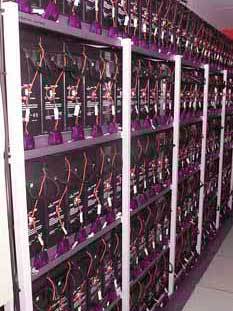
Fortunately, battery technology made big advancements over the last few decades, which means excess solar power can be stored during the day. In the evening, the power stored in batteries can be used to power homes, making them completely self-sustained.
A large number of industries also already made the transition to solar power, employing the same process that is used in domestic homes, on a larger scale.
Using solar power to become self-sustained is still fairly expensive. As solar panels become more efficient, battery technology keeps improving, and solar energy is adopted on a larger scale, prices will be driven down, making it more affordable to the general population.
The potential of solar energy should be evident by now, which is why it is considered one of the primary and important sources of renewable power. Even though many advances have already been made, we only just started to tap into the full potential of solar energy.
Solar Energy Advantages And Disadvantages
In an earlier section, some of the problems faced by the solar energy industry have already been pointed out, but we also just had a look at a fraction of its potential. Simply put, solar energy has many advantages but just as many obstacles to overcome at the moment.
The following summary will help to highlight the main advantages and disadvantages:
Advantages
- Solar panels are long-lasting with no or little maintenance required.
- No greenhouse gases are emitted or waste material generated.
- New job creation and opportunities in a fairly young industry.
- It has the potential to make us less dependent and eventually free from the use of fossil fuels.
Disadvantages
- Solar farms require and occupy large areas to generate enough energy.
- The building of components and installation of solar farms remain expensive.
- Solar energy availability is intermittent and unreliable due to the reliance on sunlight.
- The carbon footprint of solar energy remains high due to the mining of raw materials, the production process, and the transport of components.
2) Wind Power As A Renewable Energy Source
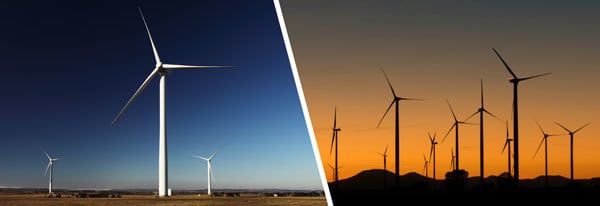
Wind farms are becoming an increasing sight all over the world. But like, solar energy, there is some lack of understanding of wind power and needs to be more precisely defined.
Wind power is the process by which mechanical energy, generated through kinetic energy, produces electrical power as a direct result of the flow of air (wind).
Wind causes the rotor blades of a turbine it is blowing through to rotate, creating kinetic energy. These turbines are turning the generators, whose mechanical power is used to generate electrical power.
How Wind Energy Is Produced
The short summary in the previous summer basically summed up the process through which wind power is generated.
To get a better understanding, imagine the shape of a wind turbine's rotor blades to like that of a helicopter. This means the blade is shaped with one side providing less resistance to air movement than the other.
When the wind blows through the blades, the difference in wind resistance allows the turbine blades to rotate, and the friction of the rotation generates kinetic power. This mechanism is connected to a generator, directly, through a shaft, or a combination of gears.
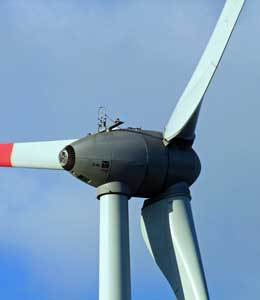
The rotation in the generator produces mechanical power, which it then uses to generate electrical energy. There are different types of generators with different blades and ways of connecting to a generator, but the principle remains the same.
On an industrial scale, a number of wind turbines are placed in the same location and connected to a central electrical substation to form a wind farm. From there, the high-voltage current can be integrated into the national power grid or relayed where needed.
Wind energy has huge potential and is the second biggest source of renewable energy in the world. For example, an onshore wind turbine is able to generate more than 6 million kWh per year, which is enough to power 1 500 European households.
The United States is aiming to have 20 percent of its energy requirements to be delivered through wind power by 2030.
Wind Energy Advantages And Disadvantages
Like solar power, some of the problems faced by the wind energy industry have already been pointed out. Wind energy has a number of advantages counting in its favor, but just as many issues and criticisms to address.
The following summary will help to highlight the main advantages and disadvantages:
Advantages
- No greenhouse gases are emitted or waste material generated.
- New job creation and opportunities in another fairly young industry.
- Wind farms can be created on existing land like farms, where it uses up a very small amount of space, as crops and grazing pastures can be used between wind turbines.
- Low maintenance and operational costs, since wind turbines can operate for very long periods without any form of direct management or service/repair.
Disadvantages
- Wind energy availability is intermittent and unreliable due to the reliance on wind.
- The noise created by the rotor blades and generators is a potential problem and has been reported as disruptive and annoying by nearby populations.
- The rotating blades of a wind turbine may pose a danger to wildlife, like birds and bats.
- Due to their huge imposing size, especially in numbers, they are often seen as unsightly, not aesthetic, and ruining the landscape.
3) Hydropower As A Renewable Energy Source
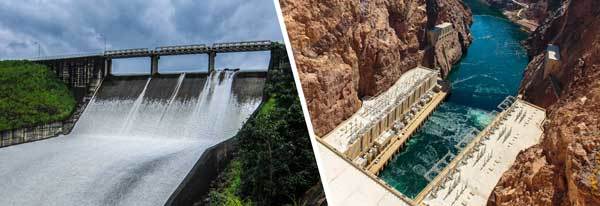
As you will soon discover, hydropower (or hydroelectric power) is generated by water. So why would it be a weather-related source of energy? It is actually quite simple since water in rivers, dams, and reservoirs is all the direct result of rainfall that has been captured.
To better understand this process, hydroelectric power needs to be more precisely defined.
Hydroelectric power is the process by which mechanical energy, generated through kinetic energy, produce electrical power as a direct result of the flow of water.
Hydroelectric power plants can usually be found in rivers or dams. The flow of water is directed through a turbine, which is connected to a generator, where kinetic energy is turned into mechanical energy used to produce electrical power.
How Hydroelectric Energy Is Produced
The generation of hydroelectric power is very similar to the process through which wind power is generated. Only in this case, the movement of water instead of air is used.
The flow of water from the dam or river, as previously described, is directed through a hydraulic turbine. The front of the turbine consists of the runner (blade), which is shaped in the same fashion as a wind turbine's rotor blade or boat propeller to help it rotate.
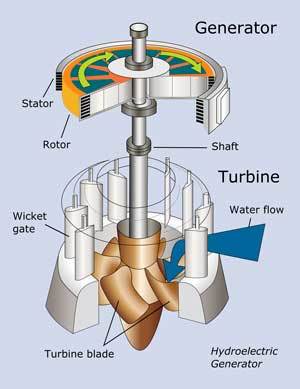
As the water passes through the runner, it causes it to spin. The runner is connected to the generator via a shaft where the kinetic energy from the rotation is turned into mechanical energy inside the generator. The mechanical energy is then used to produce electricity.
Obviously, hydroelectric energy can only be generated while water is flowing. If dams dry up and rivers run dry, no electricity can be produced.
This problem is already being addressed through a process called pumped storage. The process allows hydroelectric power stations to "renew" their source of energy (water) by replenishing water supplies on a regular basis.
During periods of peak demand, water is allowed to flow through the turbines and create power. When there is low demand, water is pumped back into the reservoir or dam from below the water turbines, to be reused during periods of high demand.
Hydroelectric energy is the most widely used source of renewable energy and accounts for roughly 7 percent of the world's total energy usage. It creates more power than all the other renewable energy sources combined. And we have only started to exploit its full potential.
Hydroelectric Energy Advantages And Disadvantages
Like all other renewable sources of energy, hydroelectric energy has many advantages. But it also comes with its own difficulties and criticisms.
The following summary will help to highlight the main advantages and disadvantages:
Advantages
- It is a very reliable source of energy, as it does not rely on sources like sunlight and wind, which are only intermittently available or completely absent.
- No greenhouse gases are emitted or waste material generated.
- It is a safe source of power compared to conventional powerplants and some other renewable sources of energy. (No fuels are used, and it does not pose the same danger to wildlife that wind turbines do.)
Disadvantages
- It is still costly to build, like conventional power stations. (But low maintenance costs offsets the cost of building and implementing a hydroelectric powerplant.)
- Hydroelectric energy is especially vulnerable to droughts. Climate change is causing extended periods of drought throughout the world and may affect regions that depend on this source of power.
- It can negatively impact the environment, as the building of dams may impact vegetation along rivers further downstream and also disrupt the natural movement of certain fish species.
Conclusion
So, can renewable energy from the weather replace fossil fuels? As you can clearly see, this a very complex issue with no easy answer. The short and "simple" answer was given first, and the article then went into more detail to provide you with the best possible information.
You will now be aware of the potential advantages, as well as the problems faced by the renewable power industry related to the weather. The three most important renewable sources of energy were highlighted, including their potential, advantages, and drawbacks.
Other sources of renewable power can also be linked to weather activity, like tidal and wave energy. Although winds mainly drive our oceans and waters, many may argue that there is not a close enough relation. As a result, it will be excluded for now.
Never miss out again when another interesting and helpful article is released and stay updated, while also receiving helpful tips & information by simply clicking on this link .
Until next time, keep your eye on the weather!

